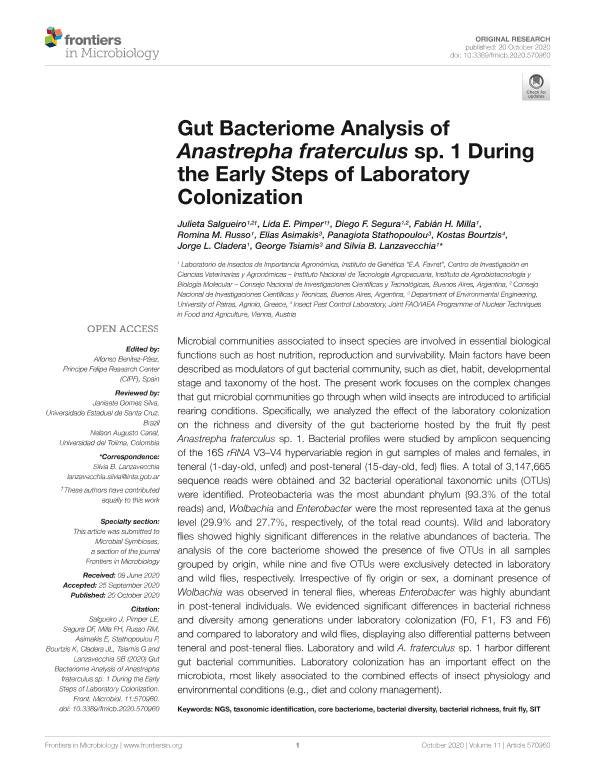Artículo
Gut Bacteriome Analysis of Anastrepha fraterculus sp. 1 During the Early Steps of Laboratory Colonization
Salgueiro, Julieta ; Pimper, Lida Elena
; Pimper, Lida Elena ; Segura, Diego Fernando
; Segura, Diego Fernando ; Milla, Fabian Horacio; Russo, Romina Maria; Asimakis, Elias; Stathopoulou, Panagiota; Bourtzis, Kostas; Cladera, Jorge Luis; Tsiamis, George; Lanzavecchia, Silvia Beatriz
; Milla, Fabian Horacio; Russo, Romina Maria; Asimakis, Elias; Stathopoulou, Panagiota; Bourtzis, Kostas; Cladera, Jorge Luis; Tsiamis, George; Lanzavecchia, Silvia Beatriz
 ; Pimper, Lida Elena
; Pimper, Lida Elena ; Segura, Diego Fernando
; Segura, Diego Fernando ; Milla, Fabian Horacio; Russo, Romina Maria; Asimakis, Elias; Stathopoulou, Panagiota; Bourtzis, Kostas; Cladera, Jorge Luis; Tsiamis, George; Lanzavecchia, Silvia Beatriz
; Milla, Fabian Horacio; Russo, Romina Maria; Asimakis, Elias; Stathopoulou, Panagiota; Bourtzis, Kostas; Cladera, Jorge Luis; Tsiamis, George; Lanzavecchia, Silvia Beatriz
Fecha de publicación:
10/2020
Editorial:
Frontiers Media
Revista:
Frontiers in Microbiology
ISSN:
1664-302X
Idioma:
Inglés
Tipo de recurso:
Artículo publicado
Clasificación temática:
Resumen
Microbial communities associated to insect species are involved in essential biological functions such as host nutrition, reproduction and survivability. Main factors have been described as modulators of gut bacterial community, such as diet, habit, developmental stage and taxonomy of the host. The present work focuses on the complex changes that gut microbial communities go through when wild insects are introduced to artificial rearing conditions. Specifically, we analyzed the effect of the laboratory colonization on the richness and diversity of the gut bacteriome hosted by the fruit fly pest Anastrepha fraterculus sp. 1. Bacterial profiles were studied by amplicon sequencing of the 16S rRNA V3–V4 hypervariable region in gut samples of males and females, in teneral (1-day-old, unfed) and post-teneral (15-day-old, fed) flies. A total of 3,147,665 sequence reads were obtained and 32 bacterial operational taxonomic units (OTUs) were identified. Proteobacteria was the most abundant phylum (93.3% of the total reads) and, Wolbachia and Enterobacter were the most represented taxa at the genus level (29.9% and 27.7%, respectively, of the total read counts). Wild and laboratory flies showed highly significant differences in the relative abundances of bacteria. The analysis of the core bacteriome showed the presence of five OTUs in all samples grouped by origin, while nine and five OTUs were exclusively detected in laboratory and wild flies, respectively. Irrespective of fly origin or sex, a dominant presence of Wolbachia was observed in teneral flies, whereas Enterobacter was highly abundant in post-teneral individuals. We evidenced significant differences in bacterial richness and diversity among generations under laboratory colonization (F0, F1, F3 and F6) and compared to laboratory and wild flies, displaying also differential patterns between teneral and post-teneral flies. Laboratory and wild A. fraterculus sp. 1 harbor different gut bacterial communities. Laboratory colonization has an important effect on the microbiota, most likely associated to the combined effects of insect physiology and environmental conditions (e.g., diet and colony management).
Archivos asociados
Licencia
Identificadores
Colecciones
Articulos (IABIMO)
Articulos de INSTITUTO DE AGROBIOTECNOLOGIA Y BIOLOGIA MOLECULAR
Articulos de INSTITUTO DE AGROBIOTECNOLOGIA Y BIOLOGIA MOLECULAR
Citación
Salgueiro, Julieta; Pimper, Lida Elena; Segura, Diego Fernando; Milla, Fabian Horacio; Russo, Romina Maria; et al.; Gut Bacteriome Analysis of Anastrepha fraterculus sp. 1 During the Early Steps of Laboratory Colonization; Frontiers Media; Frontiers in Microbiology; 11; 10-2020; 1-17
Compartir
Altmétricas



